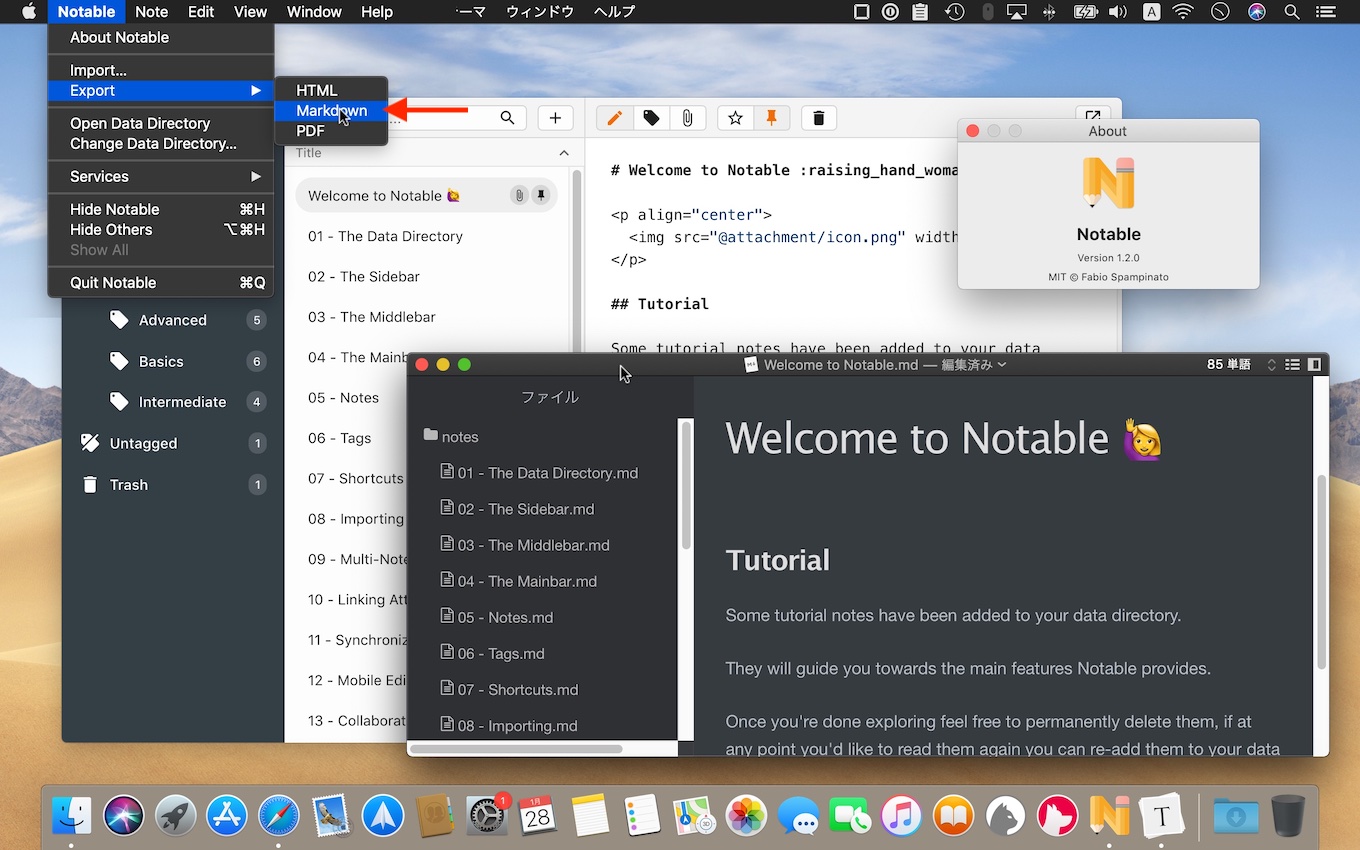Notable Markdown
I spent a lot of time recently looking for a good note taking app. Notable (electron), QOwnNotes (Qt), and Joplin (electron) are very similar, with a markdown format with the ability to switch to the rendered view or have them split side-by-side. Take your Markdown skills to the next level. Learn Markdown in 60 pages. Designed for both novices and experts, The Markdown Guide book is a comprehensive reference that has everything you need to get started and master Markdown syntax. Mark down something — mark down (something) to reduce the price of something. The machine, originally priced at $50, was marked down to $37.50. Best for: markdown formatted outlines Like FoldingText, Oak is a plain text outliner that uses Markdown-style formatting. This type of formatting is really efficient, but when you’re using text commands to style everything (for example, making a word bold by writing it as bold ), your outline will start to look messy.
Windows / Mac: I confess, I’m not as well-versed in Markdown as I should be, but the awesome, free note-taking app Notable makes me want to learn its intricacies. The app, available for both.
Inventory management will rarely be the only thing that makes a retailer successful, but it can absolutely be the something that breaks you. Knowing what your customers like is one thing, but understanding how much of each item you need on shelves and how to price them is where inventory management can go awry.
This is where one of the biggest inventory mistakes you can make exists. A pricing strategy that starts with an understanding of your brand and has an eye toward profitability is absolutely critical. Altering your price, particularly through markdowns, can be a smart strategy, but only if done correctly. Unsuccessful or excessive markdowns can lead to staggering losses in terms of missed revenue and a lower margin on your goods.
Don’t believe us? According to a 2019 study by retail think tank Coresight Research, retailers in 2018 completely missed out on roughly $300 billion in revenue, or 12 percent of total retail sales, due to markdowns. The study also revealed that most senior retail decision-makers blamed 53 percent of their unplanned markdowns on “inventory misjudgements.”
In this article, we’ll cover what markdowns are and what you need to consider as you implement a markdown strategy.
What are Retail Markdowns?
A markdown is a reduction in the price of an item due to its inability to sell for its original selling price.
For items with a specific selling season, the markdown is critical to sell inventory before the next season’s goods come. Alternatively, if you’re in the apparel or accessories industry, there is immense pressure to sell your items while they are still on-trend. Whatever the reason, markdowns are a reflection of a depreciation in your merchandise’s value.
As a simple example, let’s say you have a winter coat with an original selling price of $100. You notice that sales of the coat are weak, so you apply a 20 percent markdown, bringing the price to $80. If you paid $20 for the winter coat, your gross margin, in this case, went from 80 percent to 75 percent.
Markdowns differ from sales and discounts because they tend to be permanent, whereas sales and discounts are temporary price drops that create urgency for customers to buy now. These can include “limited time only” sales where anyone who buys the item before a certain date is entitled to a percentage off the sale price. In addition to being time-bound, sales and discounts can also be customer-specific. For example, a promotion where customers who spend at least $100 on a purchase can get 20 percent off their total order is a sale. Or, consider the employee, senior, or military discounts most stores offer. Either way, it’s customer-specific and conditional.
In both cases, sales and discounts are helpful to get some extra cash flow but are not intended to be a long-term reduction in price.
A markdown is a reduction in the price of an item due to its inability to sell for its original selling price.
How to Implement a Markdown Strategy
Markdowns can be a great way to generate cash flow and move merchandise that would otherwise sit on shelves indefinitely. But it’s not just a matter of lowering the price until people start buying an item. They have to be used strategically and with the bottom line of the business in mind. Here are some key considerations you should make when deciding whether or not to use markdowns.

Align Markdowns to Your Overall Strategy
Notable Markdown Editor
Beyond thinking about specific customer segments, you also have to consider your overall pricing strategy in light of the different customers you serve when planning markdowns.
If you are targeting budget-conscious consumers, markdowns via bundles, gifts-with-purchase, BOGO, and other similar tactics can be extremely effective.
If you are a luxury retailer, however, lower prices can detract from your perceived value as a brand. Markdowns may not appeal here at all, and so they are not an appropriate inventory management strategy.
A value pricing strategy would strike a middle ground—customers here are quality-conscious and are often willing to pay more for better things. Markdowns should be used sparingly and as a means of cross-selling/upselling other related items.
One last thing: Everyday low prices are generally not a good alternative to strategic markdowns. For example, when JC Penney replaced coupons and discounts with everyday low prices, it took away the feeling of excitement and accomplishment shoppers get when they find a deal.
Notable – Markdown Based Note-taking App For Linux ...
Plan Markdowns Throughout the Selling Season
Rather than doing one big price reduction at a certain point in the season, it’s better to set specific triggers and timeframes for markdowns. This is especially true in the apparel industry – we all know fashions do not age gracefully!
If there is a relationship between the product and the selling season, you want to use historical sales data to inform the timing and depth of your markdowns.
By understanding how customer behavior changes throughout a selling season, you can have a plan for the appropriate markdowns at the best time. Too early, and you’re losing money on customers who would have paid full price. Too late, and you’re not giving yourself runway to gradually mark prices down at the end of the season.
Then there’s the question of depth. The question of how deep to mark a price down should always consider what customers are willing to pay for the item at a given point in a season. It should be incremental and intentional as much as possible, rather than purely reactive.
Be Unpredictable with Markdowns
One of the biggest risks that comes with markdowns is the possibility of conditioning your customers to expect lower prices at certain times of the year. For example, some consumers like to wait until the end of the holiday season as possible to do Christmas shopping, knowing that there will be deeper markdowns and discounts.
Promotions are how you drum up excitement for your offerings. Just like everyday low prices, predictable markdowns and sales teach your customers that they can wait a little while and get what they want at a lower price. Your markdown timing, depth, and the items they apply to should not be the same every year.
Consider Psychological Pricing
The way your markdown prices are displayed can have a notable impact on sales. You can use psychological pricing principles when displaying marked down items to entice shoppers even further.

For example, prices ending in a nine tend to be more attractive to consumers than any other number. One study from MIT and the University of Chicago found that when they tested selling women’s clothing priced at $35 and $39, the prices ending in nine outperformed the lower prices by 24 percent. The same goes for charm pricing, where you sell something for a price ending in 99 cents rather than an even dollar amount.
Another tactic is to show the lower price (hopefully ending in a nine!) next to the original price. Showing that an item “was $100, now only $79” is a powerful draw for consumers.
Keep an Eye on the Competitive Landscape

Pricing in the age of e-commerce is a day-to-day and minute-to-minute battle. Your competitors are likely updating their prices constantly to take advantage of what their competitors are missing in the market.
The 10 Best Markdown Editors Of 2020 — Web Design Tools And ...
Conduct competitive research on a regular basis using a price intelligence tool that gives you insights into your competitors’ pricing strategies and provides data regarding consumer behavior across different segments. For example, if your competitors are starting their markdowns sooner in a given season, you want to be able to respond ASAP. Likewise, if they are offering other deals like free shipping. You always want to know you are delivering the most value to your customers while maintaining strong margins and brand value.
